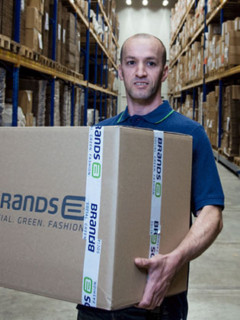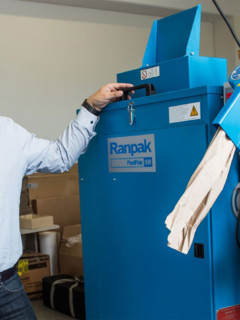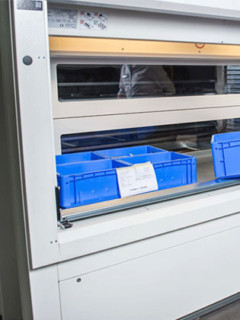Most people are eagerly waiting for it to get warmer again these days. Summertime, early blossoms and a look in the online shops and pedestrian zones tell us: summer is coming!
But not everyone is looking forward to warm temperatures. For some sectors, higher temperatures also mean greater challenges in storage and shipping.
Particularly affected are the food industry (more and more food is being bought online!) and the pharmaceutical industry (here too: online pharmacies), cosmetics, but also medical products such as laboratory samples have to reach the laboratories or hospitals at a constant temperature and reliably cooled.
Active cooling is expensive

If you regularly ship larger quantities of homogeneous refrigerated goods, it is worthwhile to transport them in a refrigerated lorry, i.e. a lorry with an air-conditioned load compartment. However, things get complicated when the goods to be transported do not “like” the same temperature. What is ideal for chocolate (around 15 degrees Celsius) is already high summer for products such as frozen vegetables (-18 degrees Celsius is ideal). Certain vegetables such as cauliflower, carrots, leeks or lettuce like it at 1-2 degrees Celsius, while tomatoes, for example, have a comfortable temperature of 12-16 degrees Celsius.
Passive cooling through suitable packaging
 Transport in a refrigerated lorry with so-called “active cooling” (energy to maintain the temperature is added from outside) is also relatively expensive. Passive cooling is cheaper and more flexible for refrigerated transport: using suitable packaging materials, the required temperature is maintained separately in each packaging unit.
Transport in a refrigerated lorry with so-called “active cooling” (energy to maintain the temperature is added from outside) is also relatively expensive. Passive cooling is cheaper and more flexible for refrigerated transport: using suitable packaging materials, the required temperature is maintained separately in each packaging unit.
Thermal packaging
Thermal boxes in combination with cold packs are a common method. As a rule, materials are used for this whose good insulating properties are also known from construction. At the top of the list: polystyrene or polystyrene foam (EPS).Read more about how thermal packagingworks and how to useit here.
But paper also has amazingly good insulating properties when used correctly.
Paper for refrigerated shipping?

In fact, paper, when used properly, can actually surpass the insulating properties of Styrofoam. Several layers of “flat” newspaper can already make quite a difference. So the pulp already brings a certain insulating performance by nature. The real “secret” of the excellent insulating properties lies in the special folding – and the air chambers, which can thus do their job optimally: Namely, insulate!
The number and arrangement of the layers as well as the height of the corrugations (e.g. in corrugated board or “crinkle paper”) influence the thermal conductivity.
The right trick with paper
Our long-time supplier Ranpak has been working and researching on the good cushioning properties of paper for a long time. With the WrapPak Protector, we have developed a machine that “folds” the natural cellulose so quickly and effectively that the paper padding not only provides excellent protection against transport damage such as knocks, scratches and breakage, but also outshines even Styrofoam with its insulating properties!Three insulation materials in the test
In the test, three chocolate bars of 850 grams each were stored and packed at 5 degrees Celsius, each with two GelPacks (680g stored at minus 10 degrees Celsius) and in a 30x25x18cm package. The conditions were identical three times, except for one difference: one was padded with polystyrene (EPS), one with aluminium-coated bubble wrap, and one with paper padding from the WrapPak Protector.Styrofoam = yellow; aluminium-coated bubble wrap = red; paper cushioning = ; paper bubble wrap blue
The result of the test:
At first, the temperature curves run fairly parallel. However, after about 18 hours, the bubble wrap literally runs out of air in terms of cooling capacity: A rapid temperature rise to up to 16 degrees Celsius after 24 hours in the package leads to an interruption of the cold chain and thus to possible damage to the product.The EPS insulation and the paper padding still have comparably good values in the test after 24 hours: the temperature in the package was around 8 degrees Celsius for both after this time.
And because the manufacturer (and we!) are convinced of this performance, we would like to convince you too:
Is switching to paper something for you? Live test for your products
If you are interested, we offer you the possibility to test your products for a more detailed analysis in Ranpak’s own climate laboratory: There, the refrigerated packaging currently used by you and the packaging developed by Ranpak will be tested under real conditions. Afterwards, a test report is created as a document for the customer.
If you are interested, please contact us via this email: maschinen@rajapack.de.
Perhaps you already have some information for us on these topics:
What would you like to send refrigerated? Type of goods, volume, weight, special features? What order volume do you expect? What transport routes? What transport duration?
Our experts will then contact you and discuss whether your product is suitable for such a test or work with you to optimise your thermal shipping packaging.


















